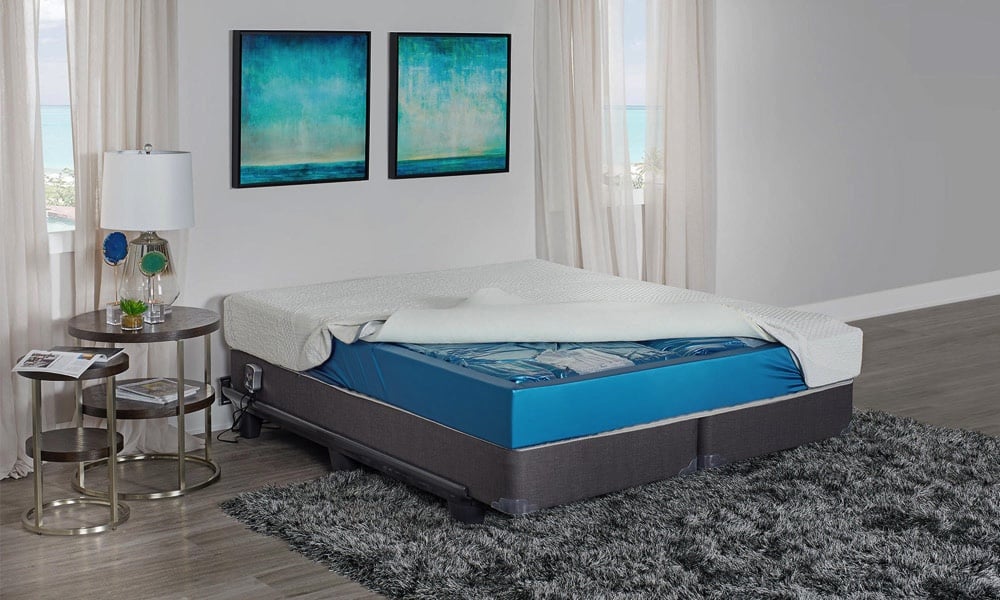Waterbeds first became popular in the early 1980s because of their form-fitting capabilities that assisted with contouring aching muscles and joints to relieve pain and tension. Modern waterbeds have come a long way since the earlier versions, but some people wonder whether their benefits exceed the extra cost and care that accompany them. This article will explore waterbed costs in total—including sometimes unseen items—to help you decide whether a waterbed is the right choice for you.
Waterbed costs can range anywhere from $75 to $3,250 depending on size and additional features. A hard-side waterbed is usually cheaper than a soft-side one with deep-fill and waveless technology, and a waterbed that is heated will cost more than a waterbed that isn’t. Most waterbeds are durable and retain their shape for 10-20 years so the costs of ownership are spread over multiple decades.
According to this article from ScienceDirect, waterbeds have many benefits including allergy reduction in allergy sufferers, because they reduce dust accumulation in the bedroom.

How Much is A Waterbed – How Size Affects Waterbed Costs
The size of a waterbed as well as the included features, like wave-reduction systems and temperature regulation, determine the price of the waterbed.
A twin-size hard-side waterbed without a water heater costs $75, while a twin-size waveless, deep-fill, soft-side waterbed costs $2,700. A double-size hard-side waterbed without a water heater costs $85, while a double-size waveless, deep-fill, soft-side waterbed costs $2,800. A Queen size hard-side waterbed without a heater costs $90, while a waveless, deep fill, soft-side Queen waterbed costs $3,070. A King size hard-side waterbed without a water heater costs $90, while a King size waveless, deep-fill, soft-side waterbed costs $3,250.
One of the cheapest waterbeds is probably a twin-size waterbed like this without a water heater which can start at $80. One of the most expensive waterbeds is this Strobel Organic Waterbed which sells for about $1,400.
Using a waterbed is a great way to reduce muscle aches and pains that result from injury or tension because it suspends the resting body on a buoyant and supportive surface that creates a feeling of weightlessness that aids relaxation. If you’re interested in learning if a waterbed is good for your back, be sure to take a look at that related article. Additionally, we have an article that provides tips to choosing between an air bed vs. a waterbed if you want to learn more about the benefits of using this type of inflatable mattress.
The distinction should be made between soft-side and hard-side water beds. A hard-side waterbed is what people typically think of when talking about waterbeds. A hard-side waterbed is a wooden frame that surrounds a vinyl bladder that is filled with water. A hard-side waterbed is often longer and wider than standard mattress sizes. A soft-side waterbed looks like a traditional mattress because it consists of a padded top layer that covers the vinyl bladder that is then enclosed in a high-density frame. Soft-side waterbeds can be used on any sturdy bed frame because they have the same dimensions as standard mattresses. This video explains the construction of a soft-side waterbed.
Twin-Size Waterbeds
A twin-size waterbed—that is soft-sided—measures 39-inches wide, 75-inches long, and approximately 9-inches high, while a hard side is 84-inches long. For information about mattress dimensions read our guide on orthopedic mattress sizes. A twin-size waterbed is suitable for use by a single person, which is why it is often a good solution for teenagers. This twin waterbed without a water heater would require a thermal waterbed heater like this one.
Double Size Waterbeds
A Double waterbed—that has soft sides—measures 54-inches wide and 75-inches long, while a hard-side double waterbed is 84-inches long. A Double size waterbed is ideal for a single person or for a couple when both people have small builds. Pets should not be allowed to sleep on a waterbed because their claws can puncture the vinyl membrane. Read our article on common airbed dangers and how to fix them for helpful tips that can also be applied to waterbeds.
How Much Does a Queen Size Waterbed Cost?
A Queen size waterbed—with soft sides—measures 60-inches wide and 80-inches long, while a hard-side Queen waterbed is 84-inches long. A Queen size hard-side bed can cost from $90, but this one costs $120 without a waterbed heater. A soft-side Queen waterbed-like this one can cost about $3,070.
What’s the Cost of a King Size Waterbed?
A King size waterbed—with soft sides—measures 76-inches wide and 80-inches long, while a hard-side King size waterbed is 84-inches long. A King size hard-side bed can cost around $90, but this one costs $175 and includes a bottle of water conditioner but excludes a waterbed heater. A soft-side King waterbed-like this one can cost about $3,250.
If you already have a waterbed and are looking to replace it with a traditional mattress, be sure to read our related article explaining what waterbed removal services are out there. You may be surprised at what you need to do to dispose of it!
How Much Does It Cost To Heat a Waterbed?
The temperature of the water inside a waterbed will gradually decrease over time, so having a waterbed heater (which can either be included with the waterbed or bought separately) will ensure that the temperature is kept at a comfortable level to encourage better sleep. According to Vera Power company, waterbed heaters use between 100 kWh to 150 kWh per month.
It costs between $7 to $10 per month and approximately $90 to $144 per year to heat a waterbed.
The thermostat in this waterbed heater will ensure that the mattress temperature remains constant according to the setting selected, which means that the heater won’t be on all the time. If you’re looking for more details on this, be sure to check out our quick tips for waterbed temperature control.
How Much Does Waterbed Insurance Cost?
The vinyl that is used in a waterbed is strong and shouldn’t leak or rupture when it is properly cared for. Some spillage may occur during filling or emptying of the waterbed which is why we suggest that you watch this video tutorial on how to fill a soft-side waterbed. But accidents do happen, so it would be best to find out if your landlord (when renting an apartment) has objections to you moving a waterbed into the home. Some landlord agreements do stipulate that additional coverage for a waterbed must be purchased by the tenant, and here is an example of that type of waterbed addendum. Waterbeds are also extremely heavy and the cost of reinforcing the floor (if necessary) should also be considered.
Waterbed liability insurance costs between $10-$20 per month in order to cover damage caused by a waterbed. Buy a waterbed addendum that covers between $100,000 to $300,000 in damage.

Be sure to take a look at our complete guide to waterbed liability insurance to find out more.
Cost of Waterbed Bedding
Soft-side waterbeds have the same standard measurements as regular mattresses, so you could use ordinary bedding, though we recommend using this 100% Cotton bedding because of its temperature regulating qualities or this Microfiber bedding because of its texture.
The cost of bedding for hard-side waterbeds is higher because they are typically 4 inches longer than regular mattresses and require bedding sets that are extra long. Bedding sets will cost around $65 for a twin-size waterbed, $70 for a double size waterbed, $80 for a queen-size waterbed, and $85 for a king-size waterbed. A waterbed safety liner may also be needed which can cost around $45.
Summary of Waterbed Bedding Costs
| Bedding Item | Example from Amazon | Price |
| Twin Size Waterbed Bedding | Ivory 600-Thread-Count 3pc Twin-Extra-Long Bed Sheet Set | ~$65 |
| Double Waterbed Bedding | Periwinkle 600-Thread-Count 4pc Full Bed Sheet Set | ~$70 |
| Queen Size Waterbed Bedding | Navy 600-Thread-Count 4pc Queen WATERBED Sheets | ~$80 |
| King Size Waterbed Bedding | Burgundy 600-Thread-Count 4pc King WATERBED Sheets | ~$85 |
Summary of Waterbed Costs
| Item | Minimum Cost | Maximum Cost | Example from Amazon |
| Waterbed (Hard-side) | ~$75 | ~$250 | California King 80% Semi Waveless Waterbed Mattress with Lumbar Support |
| Waterbed (Soft-side) | ~$500 | ~$3,250 | Strobel Organic “Sea Hero” Softside Waterbed Patented Leak-Proof |
| Waterbed Heater | ~$75 | Usually included in higher-end waterbeds | Innomax Thermal Guardian Quantum Solid State Waterbed Heater, Low Watt |
| Waterbed Bedding | ~$35 | ~$90 | White Solid Emperor/Wyoming King Size 4pc Sheet Set Up to 18″ Deep Pocket |
| Waterbed Safety Liner | ~$35 | ~$55 | Innomax Pro Max Heavy Duty Stand-Up Waterbed Safety Liner, Queen |
| Waterbed Conditioner | ~$10 | ~$35 | Blue Magic All Purpose Conditioner |
| Water (to fill the bed) | ~$2 | ~$6 | N/A |
| Electricity to heat the waterbed | ~$7 per month | ~$10 per month | N/A |
| Insurance Premium | ~$10 per month | ~$20 per month | N/A |
Related Articles:
Why did manufacturers discontinue waterbeds?
How much does a loft bed cost?
Key Takeaways
Cost Range and Influencing Factors
The cost of waterbeds significantly varies ranging from $75 to $3,250, influenced by factors like size, design (hard-side or soft-side), and additional features such as wave-reduction systems, and heating elements. The type of waterbed chosen, whether it’s a basic hard-side or a feature-rich soft-side, will majorly impact the overall cost.
Long-term Value
Waterbeds are a durable choice with a lifespan of 10-20 years, spreading the ownership costs over multiple decades. This long-term value, paired with the unique comfort and health benefits like allergy reduction and muscle relaxation, can make waterbeds a worthy investment despite the upfront costs.
Size-Specific Costs
The size of the waterbed significantly affects its price. For instance, a twin-size hard-side waterbed without a heater is much cheaper compared to a king-size soft-side waterbed with wave-reduction technology and a heater. Each size and type cater to different individual needs and preferences, reflecting in their pricing.
Heating Expenses
Heating a waterbed is a recurring cost, estimated between $7 to $10 per month, or approximately $90 to $144 per year. This expense ensures a comfortable sleeping temperature, especially in colder climates, and is an essential factor to consider when calculating the total cost of owning a waterbed.
Insurance Considerations
Waterbed liability insurance, costing between $10-$20 per month, may be a requisite especially when renting, to cover potential damages. This cost, although not directly linked to the waterbed itself, is a crucial consideration for potential waterbed owners.
Bedding and Accessory Costs
Soft-side waterbeds align with standard mattress dimensions, allowing for regular bedding use. However, hard-side waterbeds require specially sized bedding due to their unique dimensions, incurring additional costs. Moreover, other accessories like safety liners and heaters may also add to the total expenditure.
Structural Reinforcement
The substantial weight of waterbeds may necessitate floor reinforcement, especially in older homes or apartments, to prevent structural damage. This is a potentially hidden cost that should be evaluated before deciding on a waterbed purchase.
Comparative Analysis
Comparing waterbeds with traditional mattresses or air beds in terms of costs, comfort, and maintenance requirements can provide a clearer perspective on whether the benefits of waterbeds justify the associated costs and care. It’s imperative to weigh these factors against personal preferences and needs to make an informed decision.

